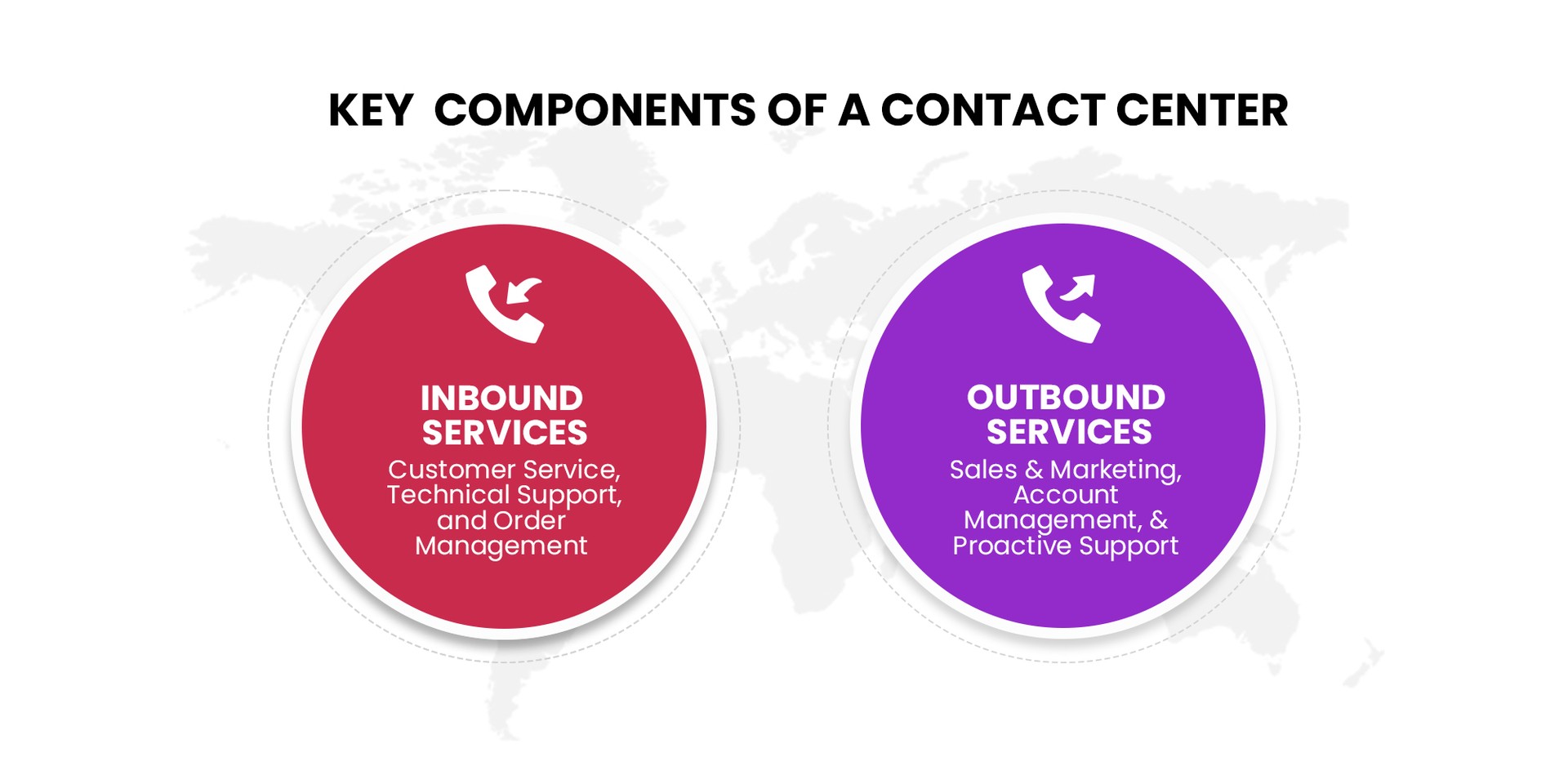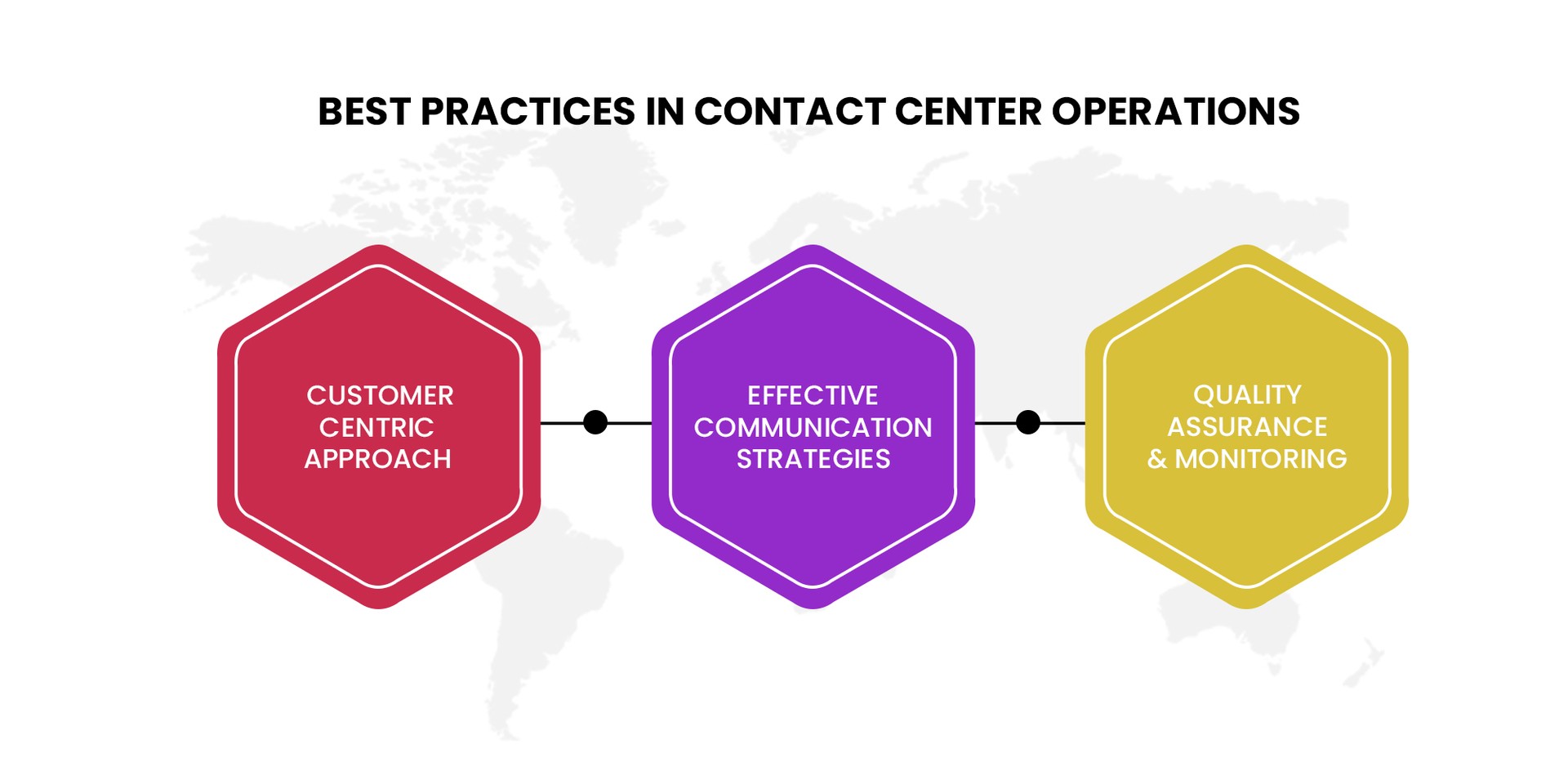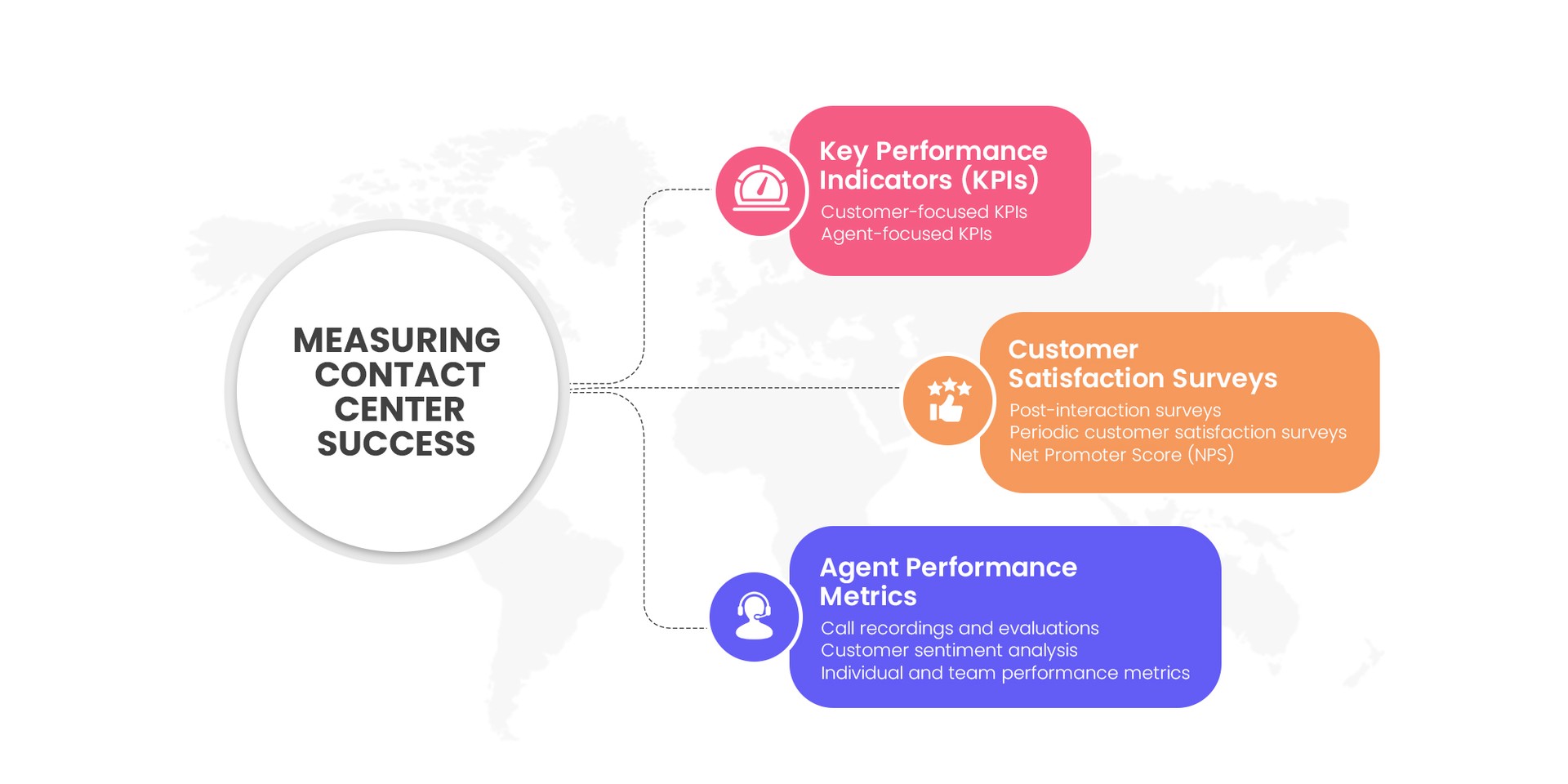
In today’s fast-paced world, customer interaction isn’t confined to face-to-face conversations. The modern business landscape thrives on multi-channel engagement, and at the heart of this lies the contact center. This bustling hub isn’t just a place for phone calls anymore; it’s a dynamic symphony of emails, chats, social media messages, and more, weaving together the intricate tapestry of customer experience.
But navigating the complex world of contact centers can be daunting. How do you ensure seamless omnichannel support? How do you empower your agents to deliver exceptional service? How do you turn this crucial touchpoint into a strategic advantage for your business?
This comprehensive guide is your key to mastering the art of call centers. We’ll dive deep into the core functions, technology trends, and best practices that transform these hubs into engines of customer satisfaction and brand loyalty.
Get ready to explore:
The evolution of contact centers: From dusty cubicles to cloud-based marvels, we’ll trace their fascinating journey and the impact on modern customer interaction.
Essential components of a thriving contact center: From inbound and outbound services to multi-channel communication and powerful technology, we’ll break down the key ingredients for success.
Unlocking the benefits: Discover how investing in contact center services leads to enhanced customer satisfaction, operational efficiency, and valuable customer insights.
Building your own bridge to customer success: We’ll guide you through the crucial steps of setting up your contact center, from designing processes to selecting the right technology and training your agents.
Navigating the rapids: We’ll tackle common challenges like peak call volumes, data security, and agent burnout, equipping you with solutions to keep your contact center running smoothly.
Riding the wave of innovation: Explore cutting-edge technology trends like AI-powered chatbots, cloud-based solutions, and CRM integration, and learn how to leverage them for ultimate success.
Gauging the pulse of your contact center: We’ll reveal the crucial metrics you need to track, from KPIs to customer satisfaction surveys and agent performance, to ensure your center is operating at peak performance.
Whether you’re a seasoned contact center pro or just starting your journey, this guide is your roadmap to success. Let’s embark on this adventure together and transform your contact center into a customer-centric oasis, a haven of exceptional service, and a powerful driver of business growth.
So, buckle up, grab your headset, and prepare to master the art of call centers. The path to customer satisfaction and brand loyalty awaits!
Understanding Contact Center Services
In today’s hyper-connected world, customer interactions extend far beyond a ringing phone. Companies need agile, multi-channel touchpoints to engage with their audiences, and that’s where contact center services step in. But what exactly are they, how have they evolved, and why are they crucial for customer-centric businesses?
Definition and Core Functions
A contact center acts as a central hub for all customer interactions, regardless of the channel: phone calls, emails, live chat, social media, messaging apps, and more. It’s like a digital switchboard, seamlessly routing inquiries to the right agents in real-time. This focus on omnichannel support distinguishes contact centers from their predecessors, the single-channel call centers.
Beyond routing, contact centers perform several core functions:
- Providing customer service: Resolving queries, complaints, and requests.
- Technical support: Troubleshooting issues with products or services.
- Sales and marketing: Generating leads, nurturing relationships, and closing deals.
- Data collection and analysis: Gathering customer feedback to improve products and services.
- Building brand loyalty: Creating positive customer experiences that drive retention.
Evolution of Contact Centers
From dusty call center cubicles to sophisticated cloud-based platforms, contact centers have undergone a significant transformation. Here are some key milestones:
1. Automated Call Distribution (ACD): Introduced in the 1960s, ACD systems intelligently routed calls based on agent availability and skillsets.
2. Interactive Voice Response (IVR): In the 1980s, IVR menus allowed callers to self-service for basic tasks, reducing agent workload.
3. Multi-channel Communication: The 1990s saw the rise of email and chat, demanding contact centers to expand beyond phone calls.
4. Cloud-based Solutions: Today, cloud-based platforms offer flexibility, scalability, and access to advanced features like AI-powered chatbots and analytics tools.
Importance in Customer-Centric Business Strategies
In today’s competitive landscape, building strong customer relationships is paramount. Contact centers play a vital role in this by:
1. Meeting customers on their preferred channels: Offering seamless omnichannel support builds convenience and fosters trust.
2. Personalizing interactions: AI and predictive analytics help tailor responses and recommendations to individual needs.
3. Collecting valuable feedback: Contact centers provide a direct line to customer sentiment, driving product and service improvements.
4. Improving operational efficiency: Automated systems and real-time data analysis optimize staffing and resource allocation.
5. Boosting brand loyalty: Positive customer experiences lead to repeat business and referrals.
Ultimately, contact center services are more than just routing calls. They are a strategic investment in customer satisfaction, loyalty, and brand reputation. By leveraging the power of omnichannel engagement, personalization, and data-driven insights, businesses can transform their contact centers into engines of customer success.
Key Components of a Contact Center
In today’s digital age, where customer expectations are soaring, a robust contact center is no longer a luxury, but a necessity. It serves as the nerve center for customer interactions, shaping perceptions and driving loyalty. But what are the key components that make a contact center truly effective? Let’s delve into the three pillars that build a bridge to customer satisfaction.
Inbound and Outbound Services
A well-equipped contact center caters to both sides of the communication spectrum. It provides:
Inbound Services
Customer Service: Addressing queries, troubleshooting issues, and resolving complaints.
Technical Support: Offering guidance and assistance with products and services.
Order Management: Processing orders, handling returns, and answering billing questions.
Outbound Services
Sales and Marketing: Generating leads, qualifying prospects, and closing deals.
Account Management: Building relationships with existing customers, offering upsell and cross-sell opportunities.
Proactive Support: Reaching out to customers pre-emptively to address potential issues or offer personalized recommendations.
By encompassing both inbound and outbound services, a contact center becomes a holistic communication hub, fostering engagement and driving business growth.

Multichannel Communication
Gone are the days of single-channel call centers. Modern customers expect seamless interaction across various platforms. A strong contact center must cater to this omnichannel reality, encompassing:
Phone: The traditional mainstay, ensuring efficient call routing and resolution.
Email: Offering asynchronous communication for detailed inquiries and documentation.
Live Chat: Enabling real-time interactions for quick questions and support.
Social Media: Engaging with customers on their preferred platforms, building community and resolving grievances.
Messaging Apps: Integrating with popular messaging platforms for convenient and personalized support.
This multichannel approach ensures customers can reach you anywhere, anytime, on their preferred platform, leading to higher satisfaction and loyalty.
Contact Center Technologies
Technology plays a pivotal role in optimizing contact center operations. Key tools include:
1. Automatic Call Distributor (ACD): Intelligently routing calls to the most suitable agent based on availability, skillset, and workload.
2. Interactive Voice Response (IVR): Guiding customers through self-service options using voice prompts and keypads, reducing agent workload.
3. Customer Relationship Management (CRM) System: Storing customer data, call history, and interaction notes for personalized service and future reference.
4. Analytics and Reporting Tools: Providing insights into agent performance, customer satisfaction, and call center efficiency, enabling data-driven decisions.
5. AI-powered Chatbots: Handling basic inquiries and offering 24/7 support, freeing up agents for complex issues.
Investing in these technologies not only optimizes agent productivity and call handling times, but also delivers a faster, more efficient, and ultimately more satisfying experience for customers.
By focusing on these core components – a comprehensive range of services, omnichannel communication, and powerful technology – businesses can build contact centers that are not just operational hubs, but strategic assets that drive customer satisfaction, brand loyalty, and ultimately, business success.
Benefits of Implementing Contact Center Services
In an experience-driven business model, contact centers are no longer optional add-ons, but strategic investments. Implementing robust contact center services unlocks a treasure trove of benefits, empowering businesses to forge stronger customer relationships, streamline operations, and make data-driven decisions. Let’s explore three key advantages of investing in a well-oiled contact center.
Enhanced Customer Satisfaction
A thriving contact center becomes the cornerstone of positive customer experiences. Here’s how:
1. Omnichannel Engagement: Reach customers on their preferred platforms – phone, email, chat, social media – fostering convenience and accessibility.
2. Personalized Interactions: Leverage insights from call history and data analytics to tailor responses and recommendations, delivering a sense of value and recognition.
3. Faster Resolution Times: Efficient call routing, self-service options like IVR and chatbots, and skilled agents all contribute to resolving issues quickly, minimizing customer frustration.
4. Proactive Support: Anticipate needs and go the extra mile by reaching out pre-emptively with helpful information or personalized offers, exceeding expectations and building trust.
Ultimately, a well-managed contact center translates into happier customers, higher satisfaction scores, and increased loyalty.
Increased Operational Efficiency
Beyond customer experience, contact centers offer internal benefits as well:
1. Improved Agent Productivity: Automated tasks, like call routing and data entry, free up agents’ time for more complex interactions, boosting their output and reducing call handling times.
2. Real-time Data and Analytics: Monitor call volume, agent performance, and customer sentiment in real-time, enabling strategic decision-making and resource allocation.
3. Workforce Management: Optimize scheduling and staffing levels based on call volume and agent availability, minimizing downtime, and ensuring efficient resource utilization.
4. Scalability and Flexibility: Cloud-based solutions allow you to easily scale your contact center up or down based on needs, accommodating seasonal fluctuations and growth without heavy infrastructure investments.
In essence, a well-equipped contact center streamlines operations, optimizes costs, and fosters a productive agent environment.
Improved Customer Insights and Analytics
Contact centers are goldmines of customer data: call recordings, transcripts, chat logs, and surveys provide valuable insights into customer behavior, needs, and preferences. This data can be leveraged to:
1. Identify trends and patterns: Understand common customer issues, product performance, and campaign effectiveness, informing product development, marketing strategies, and service improvements.
2. Personalize communications: Tailor marketing messages, product recommendations, and support based on individual customer profiles and buying journeys.
3. Predict customer behavior: Leverage AI and data analytics to anticipate customer needs and proactively offer relevant solutions, fostering customer satisfaction and engagement.
By harnessing the power of customer data, businesses can gain a deeper understanding of their audience, make informed decisions, and ultimately drive growth and success.
Setting Up a Contact Center
A robust contact center acts as a lifeblood for businesses, connecting them with their customers and shaping brand perception. But building this crucial bridge to customer success requires careful planning and execution. Let’s look into the three key steps for setting up a thriving contact center.
Designing Contact Center Processes
Before technology or agents come into play, you need a solid blueprint:
1. Define your goals: What are your objectives? Resolving customer queries, driving sales, or providing technical support? Understanding your purpose guides your entire setup.
2. Map customer journeys: Analyze how customers interact with your brand – touchpoints, pain points, and preferred channels. This helps tailor processes for a seamless experience.
3. Develop call flows and scripts: Design efficient workflows for various inquiries, ensuring consistent messaging and clear resolution paths.
4. Establish quality metrics: Define key performance indicators (KPIs) to track agent performance, customer satisfaction, and operational efficiency.
Remember, your processes should be flexible and adaptable to evolving customer needs and market trends.
Selecting Appropriate Technologies
Technology fuels your contact center’s performance, so choose wisely:
1. Automatic Call Distributor (ACD): Route calls efficiently based on agent availability, skillsets, and workload.
2. Interactive Voice Response (IVR): Offer self-service options for basic inquiries, reducing agent workload and wait times.
3. Customer Relationship Management (CRM) System: Manage customer data, call history, and interaction notes for personalized service and future reference.
4. Omnichannel Communication Tools: Integrate phone, email, chat, social media, and messaging apps for seamless customer engagement across platforms.
5. Analytics and Reporting Software: Gain insights into agent performance, customer sentiment, and call center efficiency to inform data-driven decisions.
Prioritize user-friendly interfaces, robust security, and seamless integration for optimal agent productivity and customer experience.
Training and Onboarding Contact Center Agents
Your agents are the heart and soul of your contact center. Invest in their success:
1. Comprehensive training: Develop training programs encompassing product knowledge, communication skills, problem-solving techniques, and company policies.
2. Role-playing and simulations: Provide a safe space for agents to practice handling calls, navigating challenging situations, and applying best practices.
3. Continuous learning and development: Foster a culture of ongoing learning with knowledge updates, skill development opportunities, and feedback mechanisms.
4. Performance coaching and mentoring: Offer individualized feedback and guidance to help agents improve their skills and confidence.
Remember, happy and well-trained agents translate into exceptional customer service, positive interactions, and brand loyalty.
Best Practices in Contact Center Operations
Exceptional customer experiences are no longer a luxury, but a necessity. And your contact center plays a pivotal role in orchestrating these experiences. But how do you ensure flawless operations that translate into delighted customers and thriving business? Let’s dive into three key best practices that set your contact center apart.
Customer-Centric Approach
Put your customers at the heart of everything you do. Here’s how:
1. Empathy and Active Listening: Train agents to actively listen, empathize with customer concerns, and communicate with genuine care.
2. Personalization: Leverage data and past interactions to personalize responses and recommendations, making customers feel valued and understood.
3. Resolve First Contact: Aim to resolve issues on the first interaction whenever possible, minimizing frustration and exceeding expectations.
4. Omnichannel Accessibility: Offer seamless transitions between different channels, ensuring customers can reach you on their preferred platform.
Remember, happy customers are loyal customers. Focus on building genuine connections and exceeding expectations at every touchpoint.
Effective Communication Strategies
Communication is the bridge between your agents and your customers. Hone your skills:
1. Clear and Concise Language: Avoid jargon and technical terms, speak clearly and articulately, and actively verify understanding.
2. Positive and Upbeat Tone: Maintain a professional yet friendly demeanor, even in challenging situations. A positive attitude can go a long way.
3. Active Problem-Solving: Don’t just listen, actively work with the customer to find solutions, offering options and explaining next steps clearly.
4. Follow-up and Feedback: After resolving an issue, follow up to ensure customer satisfaction and encourage feedback to continuously improve.
Effective communication fosters trust, builds rapport, and leaves a lasting positive impression.
Quality Assurance and Monitoring
Continuous improvement is key. Implement these measures:
1. Call Monitoring and Evaluation: Regularly monitor calls for adherence to best practices, agent performance, and customer sentiment.
2. Feedback and Coaching: Provide constructive feedback and coaching to agents based on call evaluations, helping them continuously improve.
3. Reporting and Analytics: Track key performance indicators (KPIs) like call handling times, customer satisfaction scores, and resolution rates to identify areas for improvement.
4. Technology and Automation: Leverage technology to automate repetitive tasks, free up agent time for complex interactions, and improve overall efficiency.
Quality assurance helps identify and address issues, optimize processes, and ensure your contact center consistently delivers exceptional service.

Challenges and Solutions in Contact Centers
The bustling world of contact centers is ripe with opportunity, but also rife with challenges. Mastering these hurdles is crucial for creating a smooth-sailing customer experience and a thriving business. Let’s explore three key challenges and how to navigate them with confidence.
Handling Peak Call Volumes
Surge hours and unexpected influxes can leave even the most prepared contact center feeling overwhelmed. Here’s how to stay afloat:
1. Accurate Forecasting: Analyze historical data and industry trends to anticipate peak periods and adjust staffing accordingly.
2. Flexible Workforce Management: Utilize part-time agents, work-from-home options, and overtime incentives to readily increase staff during busy times.
3. Smart Call Routing: Employ an ACD (Automatic Call Distributor) that efficiently routes calls based on agent skills and availability, minimizing wait times.
4. Self-Service Options: Implement AI-powered chatbots and IVR systems to handle basic inquiries, freeing up agents for complex issues during peak hours.
By anticipating surges and deploying flexible solutions, you can keep the call flow smooth, and customers satisfied, even when the waves are high.
Ensuring Data Security and Compliance
Customer data is precious, and its protection is paramount. Navigate the intricate legal landscape with these measures:
1. Robust Cybersecurity: Invest in state-of-the-art firewalls, data encryption, and intrusion detection systems to safeguard sensitive information.
2. Compliance Training: Train agents on relevant data privacy regulations and best practices for handling customer data securely.
3. Regular Audits and Reviews: Conduct periodic audits of your data security protocols and systems to identify and address potential vulnerabilities.
4. Incident Response Planning: Develop a clear plan for how to respond to data breaches and other security incidents, minimizing impact and restoring trust.
By prioritizing data security and compliance, you build trust with your customers and mitigate the risks associated with data breaches.
Addressing Agent Burnout
Repetitive tasks, high pressure, and demanding customers can lead to agent fatigue and burnout. Keep your team afloat with these strategies:
1. Job Rotation and Varied Tasks: Offer opportunities for agents to rotate between different types of calls, preventing monotony and boosting engagement.
2. Positive Work Environment: Foster a supportive and collaborative culture where agents feel valued and appreciated.
3. Stress Management Techniques: Provide training and resources on stress management techniques to help agents cope with challenging situations.
4. Career Development Opportunities: Offer continuous learning programs and career advancement pathways to motivate and retain agents.
By investing in your agents’ well-being and career growth, you create a positive and productive work environment that fosters resilience and reduces burnout.
Technology Trends in Contact Center Services
The contact center is undergoing a revolution, propelled by cutting-edge technologies that reimagine customer interaction and optimize operations. Here, we’ll dive into three key trends reshaping the topography.
Artificial Intelligence and Chatbots
AI is no longer science fiction; it’s transforming contact centers through:
1. AI-powered Chatbots: Handle routine inquiries, schedule appointments, and answer FAQs 24/7, reducing agent workload and wait times.
2. Sentiment Analysis: Gauge customer emotions during interactions, allowing agents to adjust communication styles and proactively address concerns.
3. Predictive Analytics: Anticipate customer needs and proactively offer personalized recommendations, enhancing experiences and driving sales.
By leveraging AI, contact centers can provide faster, more efficient, and even proactive customer support, boosting satisfaction and brand loyalty.
Cloud-Based Contact Centers
Ditch the bulky hardware and embrace the flexibility of the cloud:
Scalability on Demand: Easily scale your contact center up or down based on seasonal fluctuations and growth, avoiding high infrastructure costs.
Remote Workforce Management: Empower agents to work from anywhere, maximizing talent pool and improving work-life balance.
Real-time Data and Analytics: Gain instant insights into agent performance, customer sentiment, and call traffic, enabling data-driven decisions.
Cloud-based solutions offer agility, efficiency, and cost savings, making them a game-changer for modern contact centers.
Integration with Customer Relationship Management (CRM) Systems
Break down data silos and create a holistic customer view:
1. Seamless Data Flow: Automatically sync customer data between the contact center and CRM, eliminating manual entry and ensuring accuracy.
2. Personalized Interactions: Leverage CRM data to tailor responses, recommendations, and offers based on individual customer needs and preferences.
3. Improved Agent Performance: Equip agents with instant access to customer history and context, enabling faster resolution and better service.
CRM integration allows contact centers to deliver personalized, consistent, and data-driven customer experiences, boosting satisfaction and loyalty.
Measuring Contact Center Success
In the dynamic world of contact centers, knowing what and how to measure is crucial. It’s like taking a vital sign, allowing you to diagnose strengths, identify areas for improvement, and ultimately deliver exceptional customer experiences. So, let’s explore three keyways to measure your contact center’s success.
Key Performance Indicators (KPIs)
These are your quantifiable markers of success, reflecting your operational efficiency and customer experience:
Customer-focused KPIs
1. First Contact Resolution (FCR): Percentage of issues resolved on the first interaction, reflecting efficiency and customer satisfaction.
2. Average Handle Time (AHT): Average time to handle a call, showing call center efficiency and agent productivity.
3. Customer Satisfaction (CSAT) Score: Measured through surveys, it reveals how satisfied customers are with the experience.
Agent-focused KPIs
1. Agent Occupancy Rate: Percentage of time agents are actively engaged in calls or tasks, showcasing resource utilization.
2. Average Speed of Answer (ASA): Time it takes for an agent to answer a call, indicating customer wait times and staffing levels.
3. Absenteeism and Attrition Rates: Reflecting agent well-being and engagement, impacting service quality and operational costs.
By monitoring these KPIs and setting achievable targets, you can track progress, identify areas for improvement, and ensure your contact center operates at peak performance.
Customer Satisfaction Surveys
Go beyond numbers and hear directly from your customers:
Post-interaction surveys: Capture immediate feedback on the quality of the interaction, agent courtesy, and issue resolution.
Periodic customer satisfaction surveys: Gauge overall satisfaction with the contact center, identify common pain points, and track sentiment over time.
Net Promoter Score (NPS): Measures customer loyalty and likelihood to recommend your brand, highlighting strengths and potential areas for improvement.
Remember, happy customers are loyal customers. By actively listening to their feedback and acting on their concerns, you build trust and drive positive word-of-mouth.
Agent Performance Metrics
Your agents are the face of your brand, so monitor their performance to ensure quality and consistency:
Call recordings and evaluations: Assess agent communication skills, problem-solving approaches, and adherence to call protocols.
Customer sentiment analysis: Evaluate how customers respond to agent interactions, identifying areas for improvement in communication style and empathy.
Individual and team performance metrics: Track call handling times, resolution rates, and customer satisfaction scores assigned to each agent, providing personalized feedback and coaching opportunities.
By evaluating agent performance and providing tailored support, you empower your team to deliver exceptional service and consistently exceed customer expectations.

Conclusion: Let JindalX Orchestrate Your Customer Symphony
This comprehensive guide has hopefully painted a vivid picture of the dynamic world of contact centers and their undeniable importance in today’s customer-centric business landscape. We’ve explored the intricacies, the challenges, and the immense potential these hubs hold for fostering customer satisfaction and driving brand loyalty.
But the journey doesn’t end here. Now is the time to translate insights into action, to transform your own contact center into a masterpiece of customer engagement. And that’s where JindalX steps in. We’re not just guides, we’re architects of customer experience. We leverage our expertise, cutting-edge technology, and data-driven strategies to craft smart call centers tailored to your unique business needs.
With JindalX as your partner, you can:
Design efficient processes: We’ll work with you to map customer journeys, define your goals, and develop streamlined workflows for every interaction.
Harness the power of technology: We’ll recommend the optimal blend of tools, from ACDs and IVRs to AI-powered chatbots and CRMs, ensuring seamless omnichannel support.
Build a world-class team: We’ll help you train and empower your agents with the skills, knowledge, and empathy they need to deliver exceptional service.
Track your progress and optimize: We’ll implement robust KPIs and reporting systems to measure your success and refine your strategies for continuous improvement.
JindalX isn’t just about setting up a contact center, it’s about orchestrating a symphony of customer satisfaction. We’ll help you harmonize every touchpoint, from the first call to the final resolution, leaving your customers with a lasting melody of delight.
So, let us turn to the final page of this guide and open the first chapter of your contact center success story. Contact JindalX today, and let our expertise orchestrate the customer experience that sets your business apart.
Remember, in the age of the empowered customer, your contact center isn’t just a cost center, it’s a stage for exceeding expectations and building lifelong relationships. With JindalX by your side, you’re not just mastering call centers, you’re mastering the art of customer loyalty.
So, why wait? Reach out and let the music begin!


